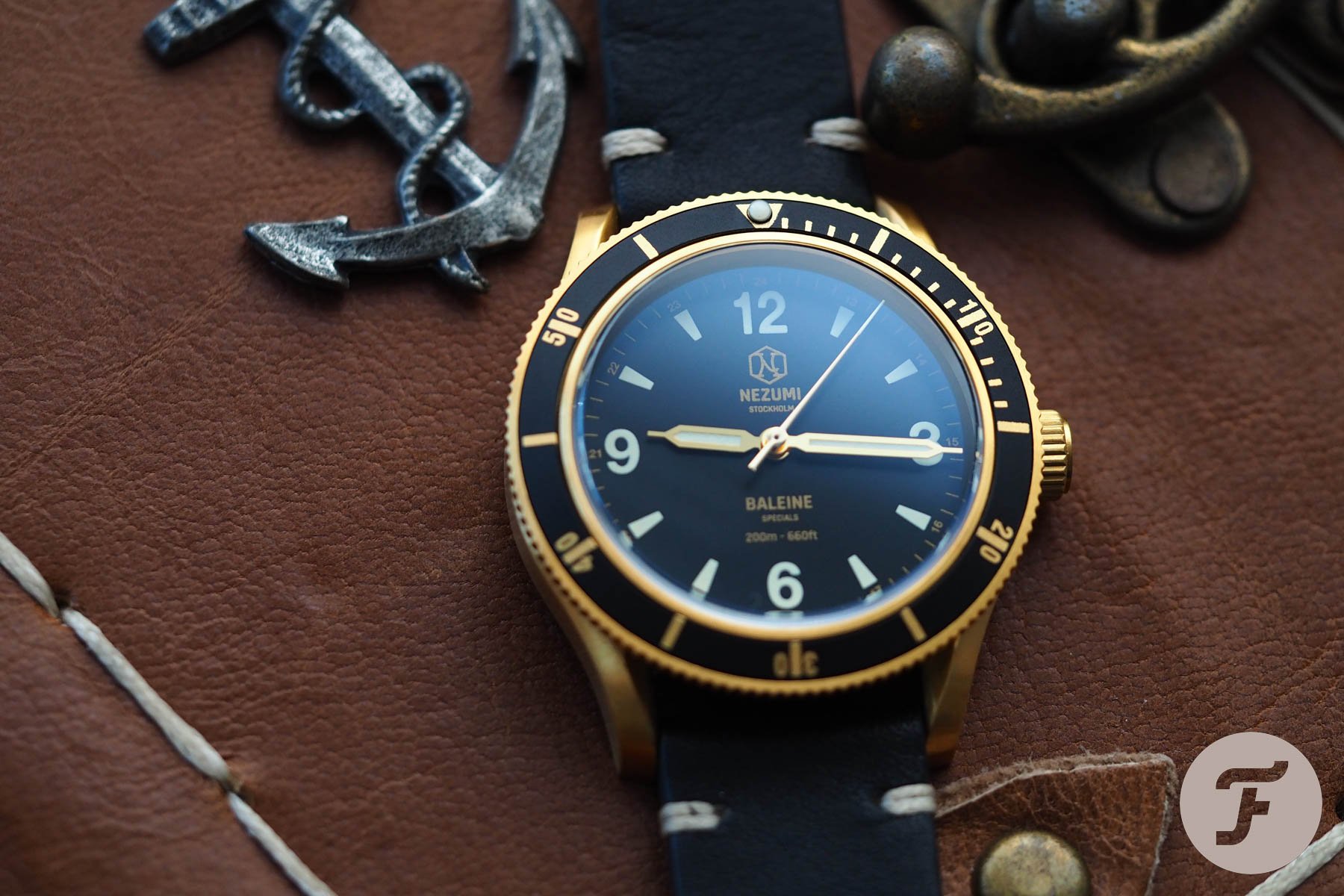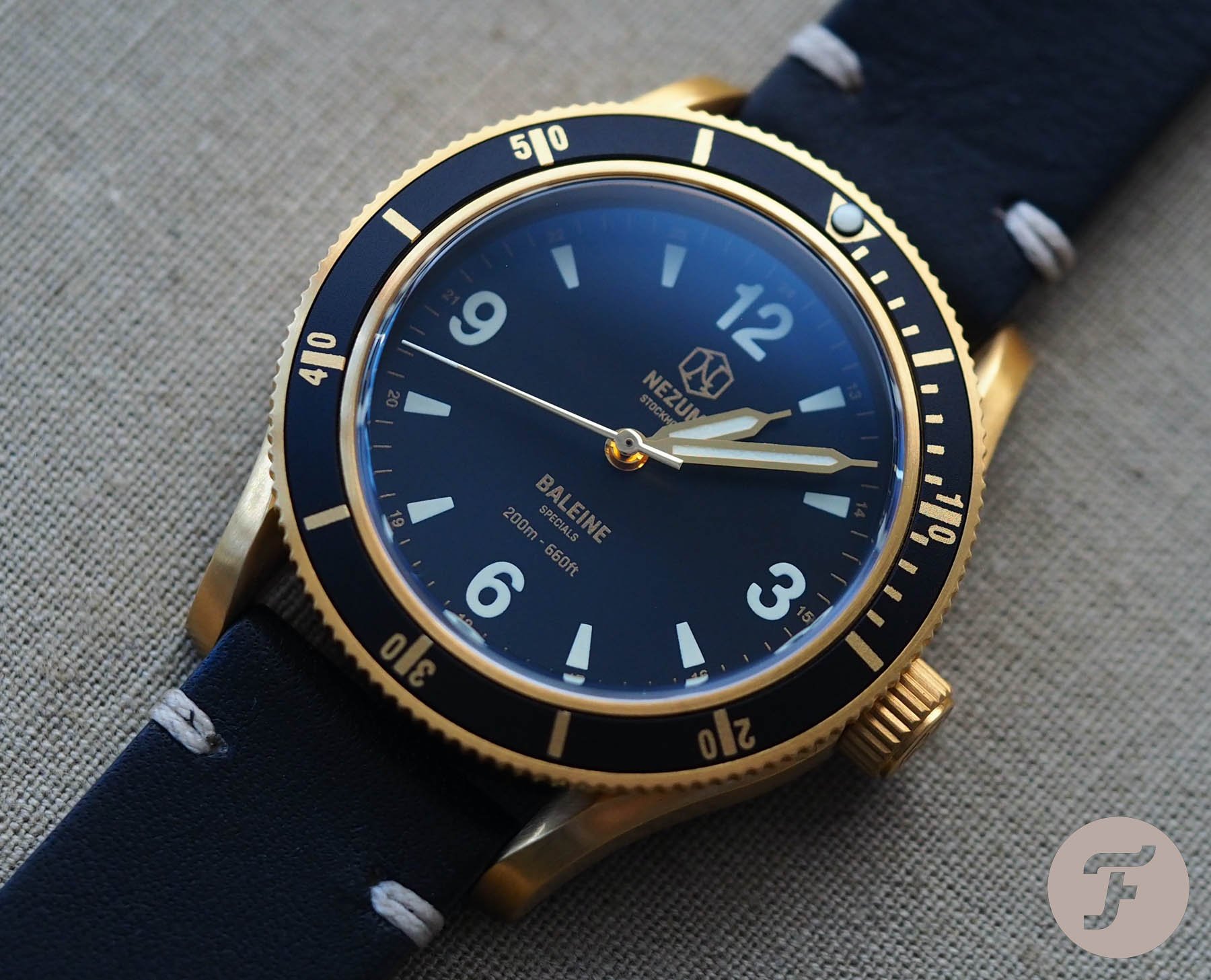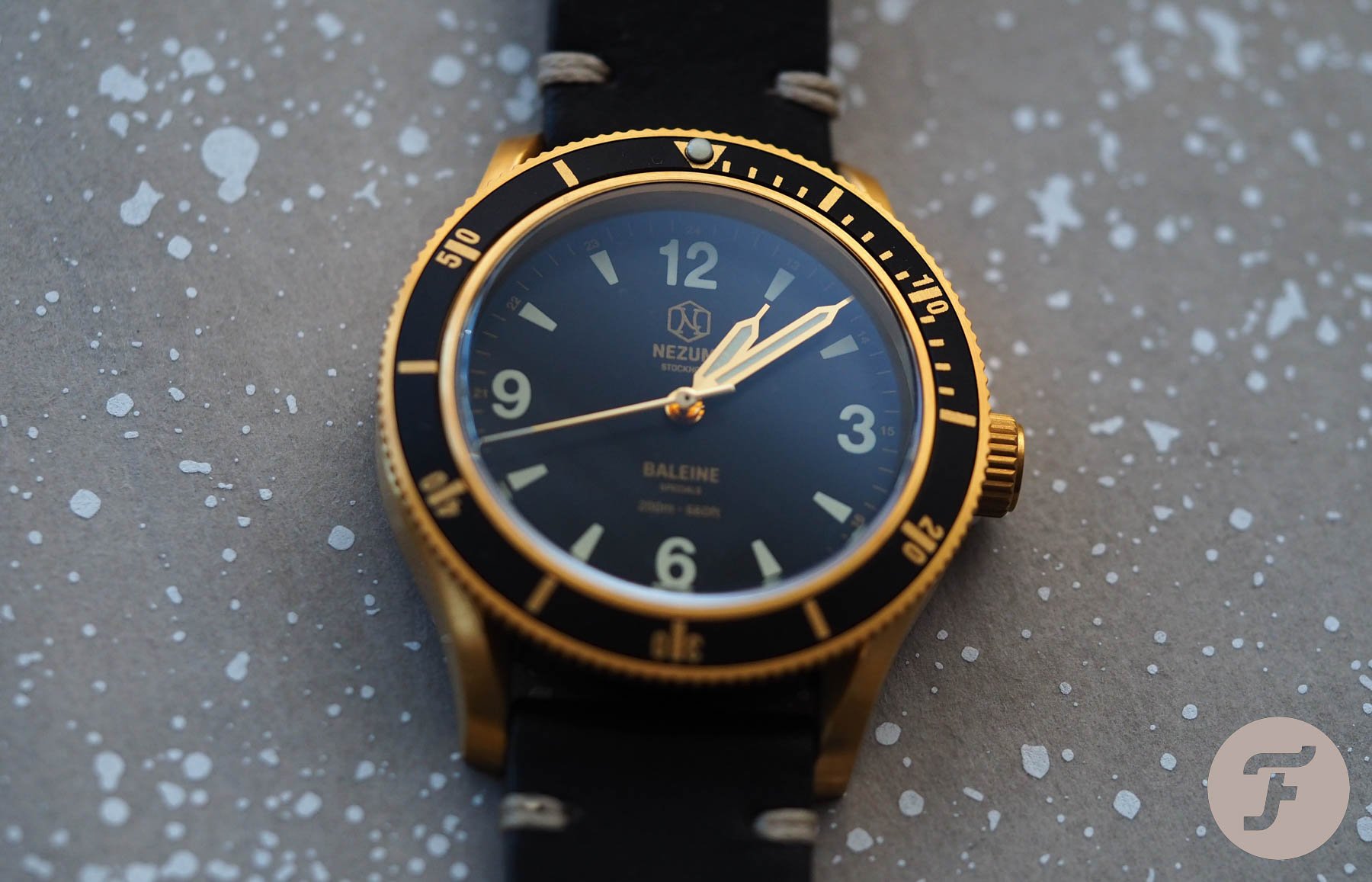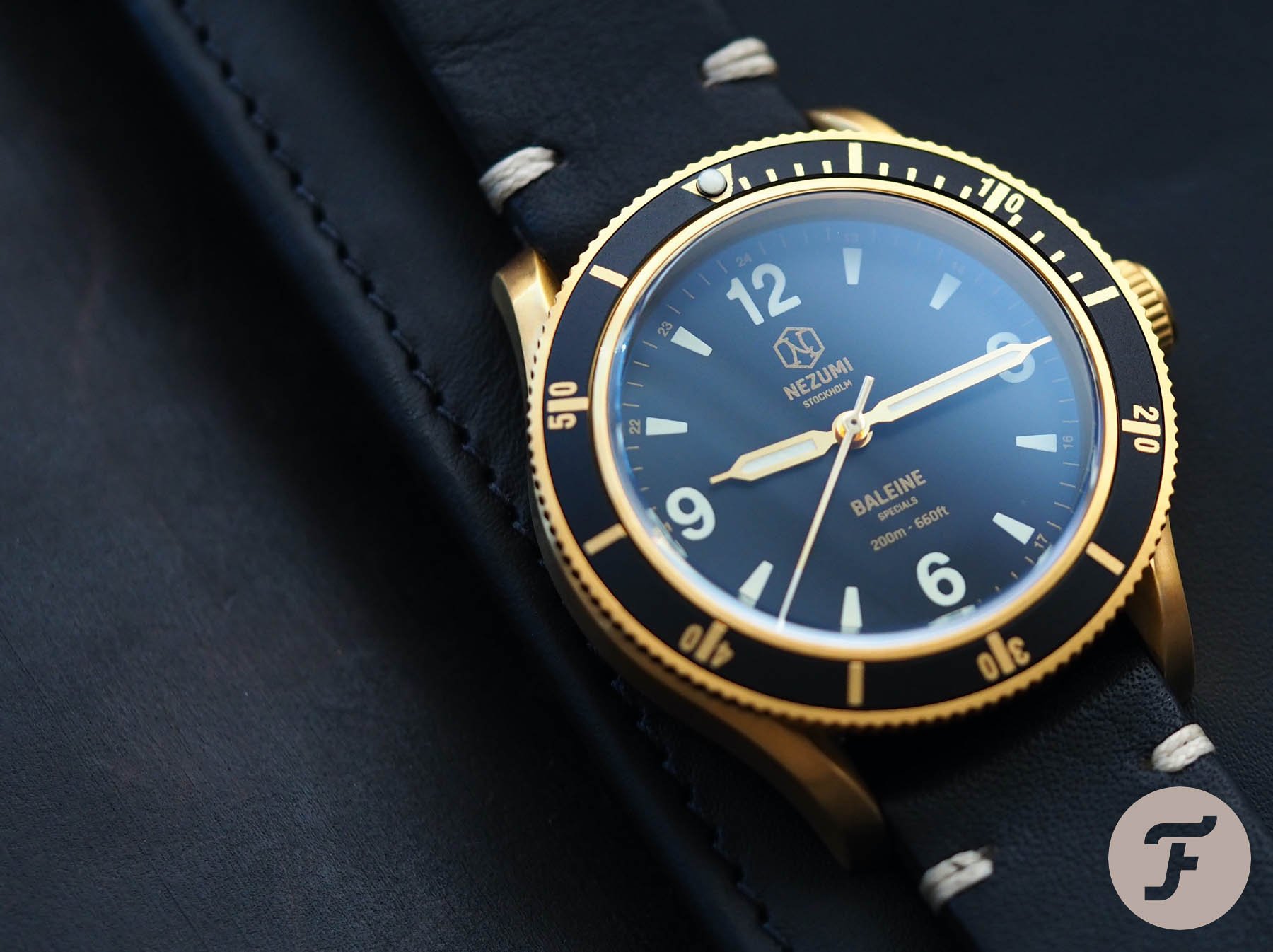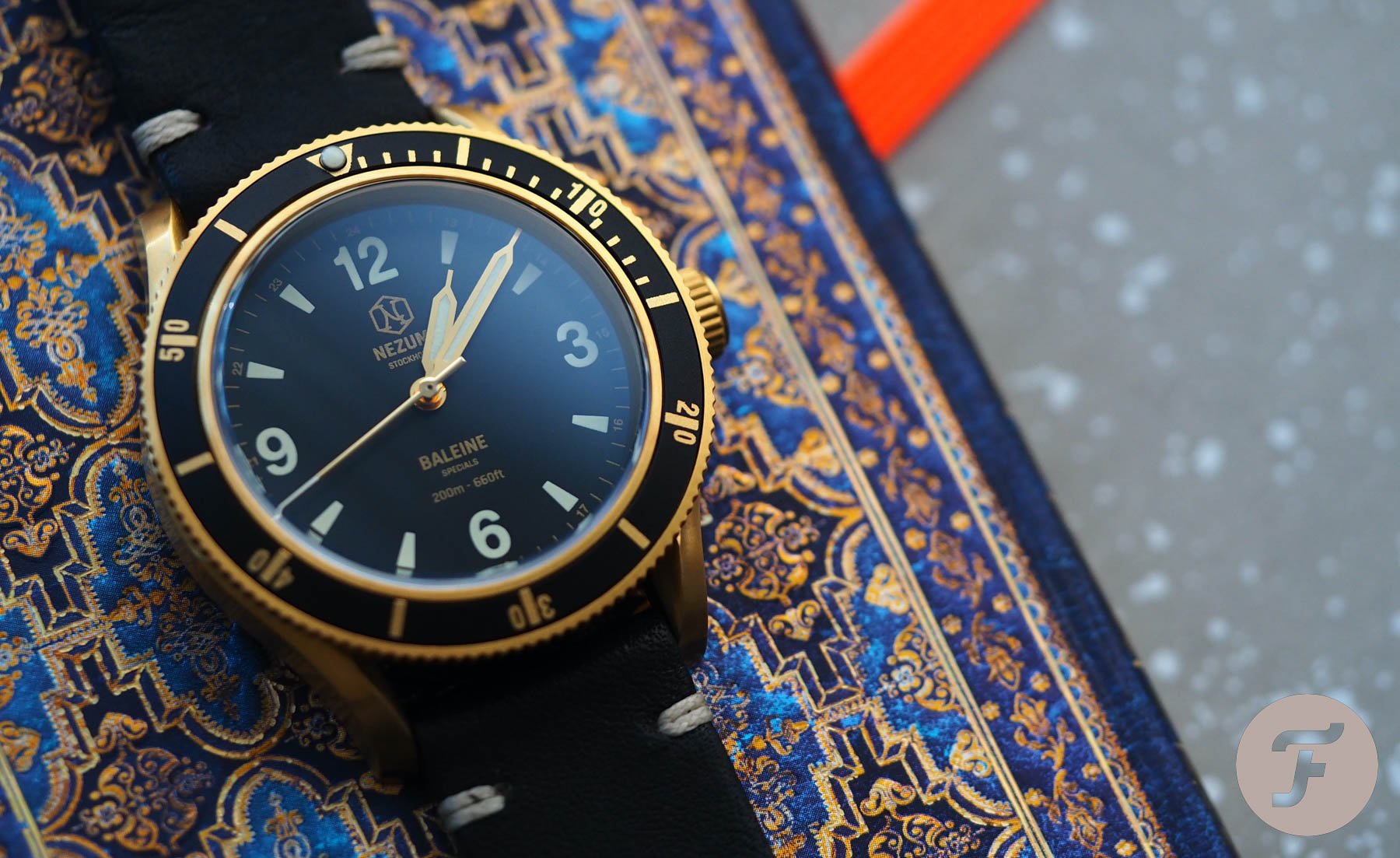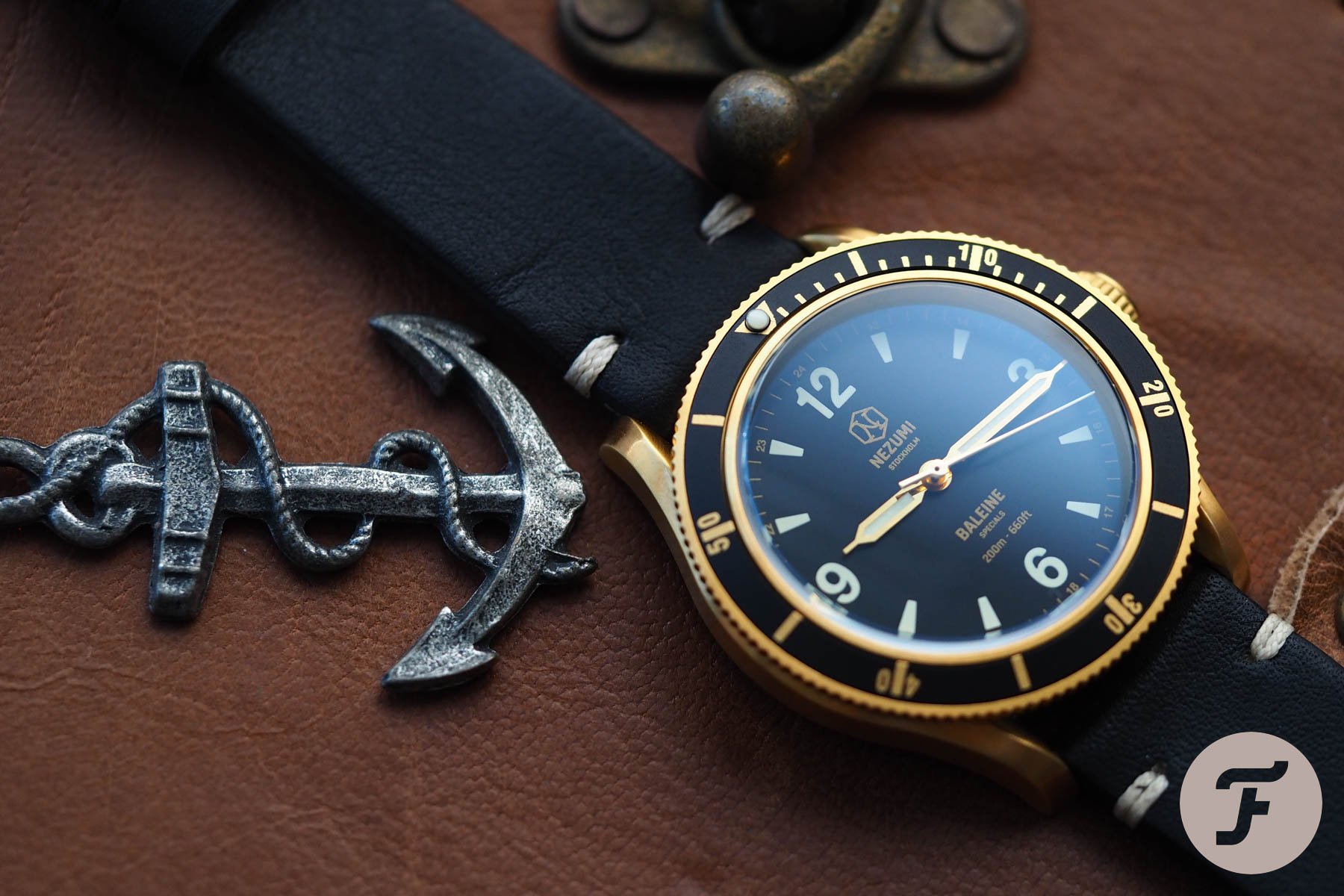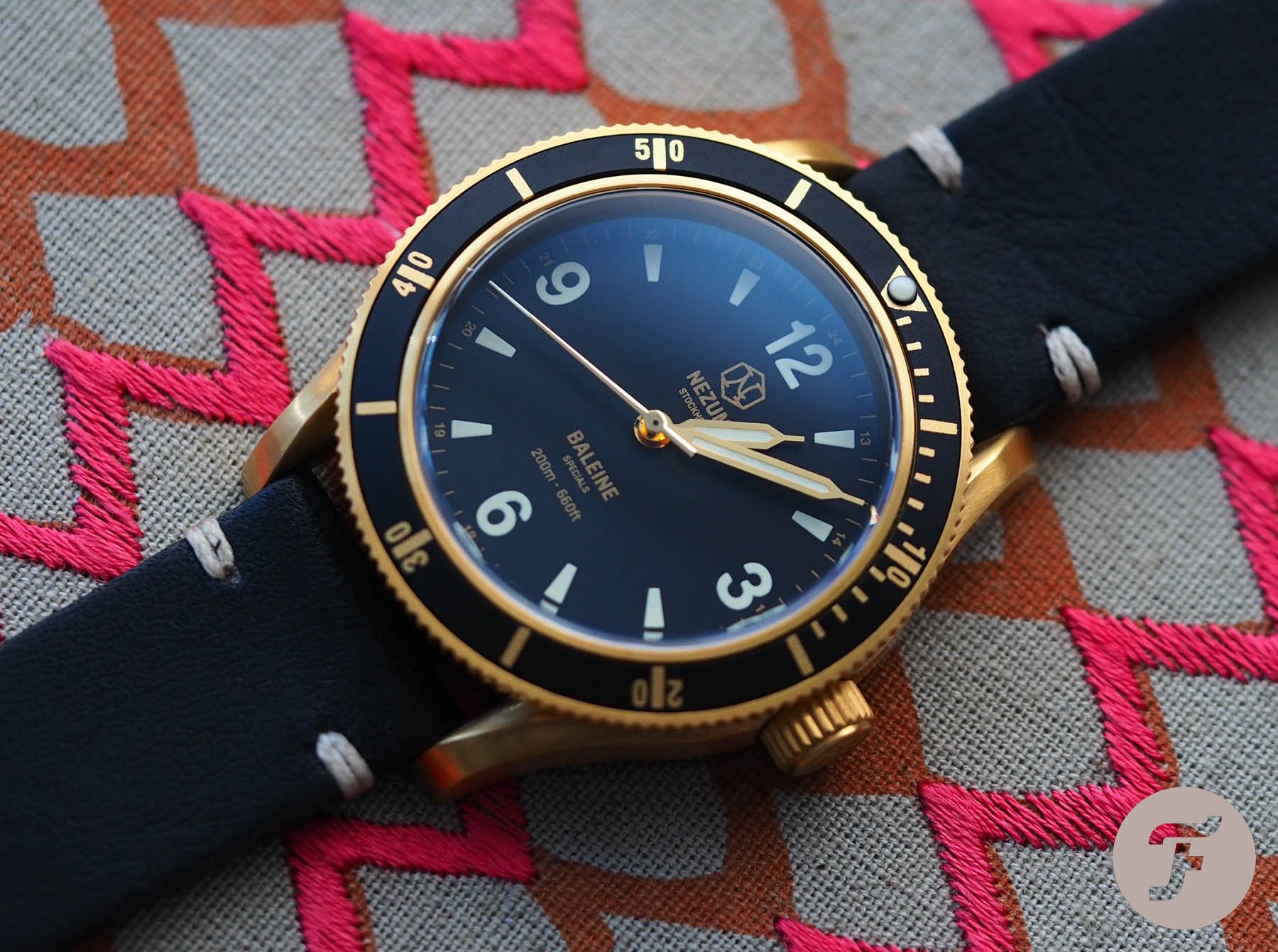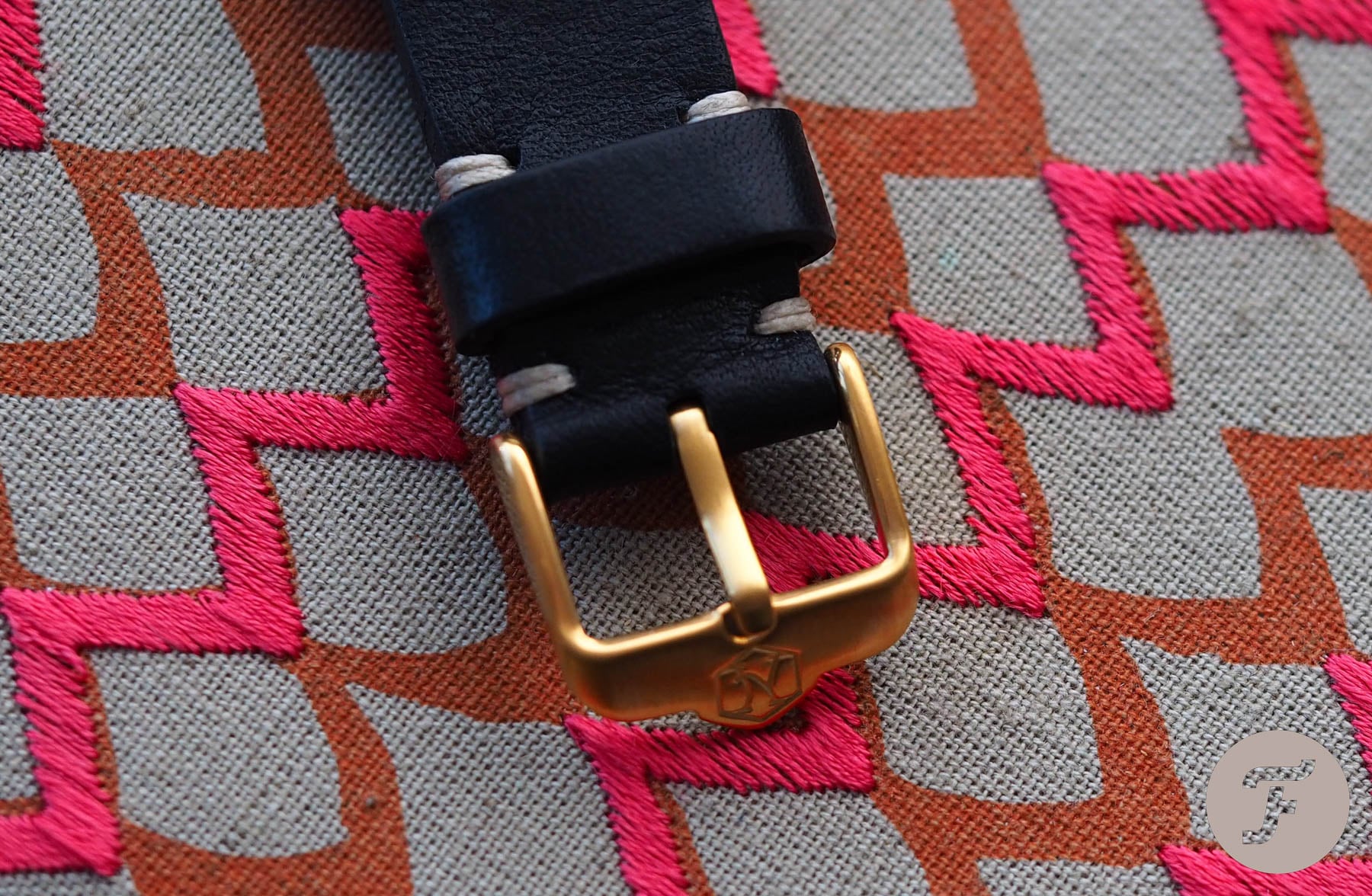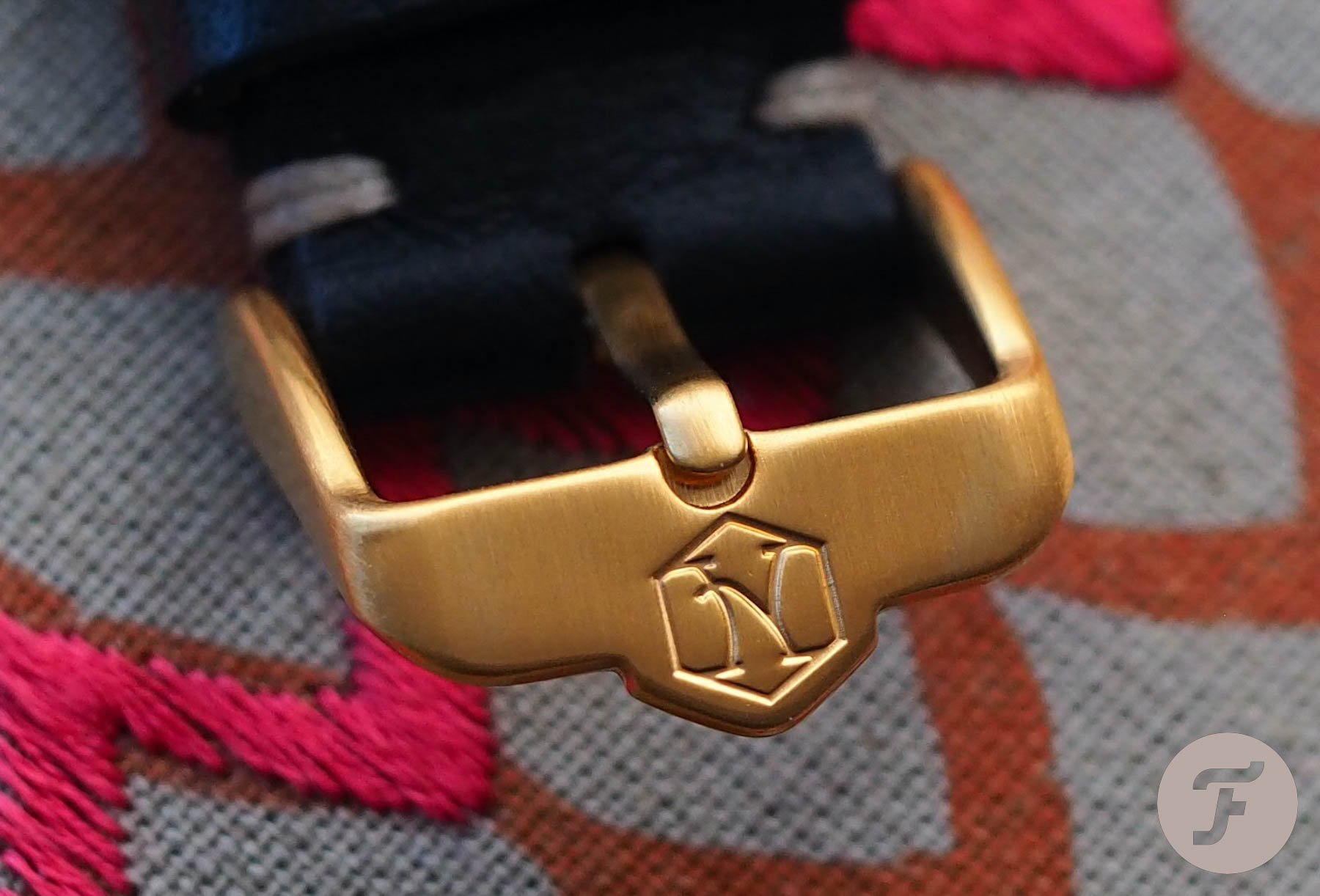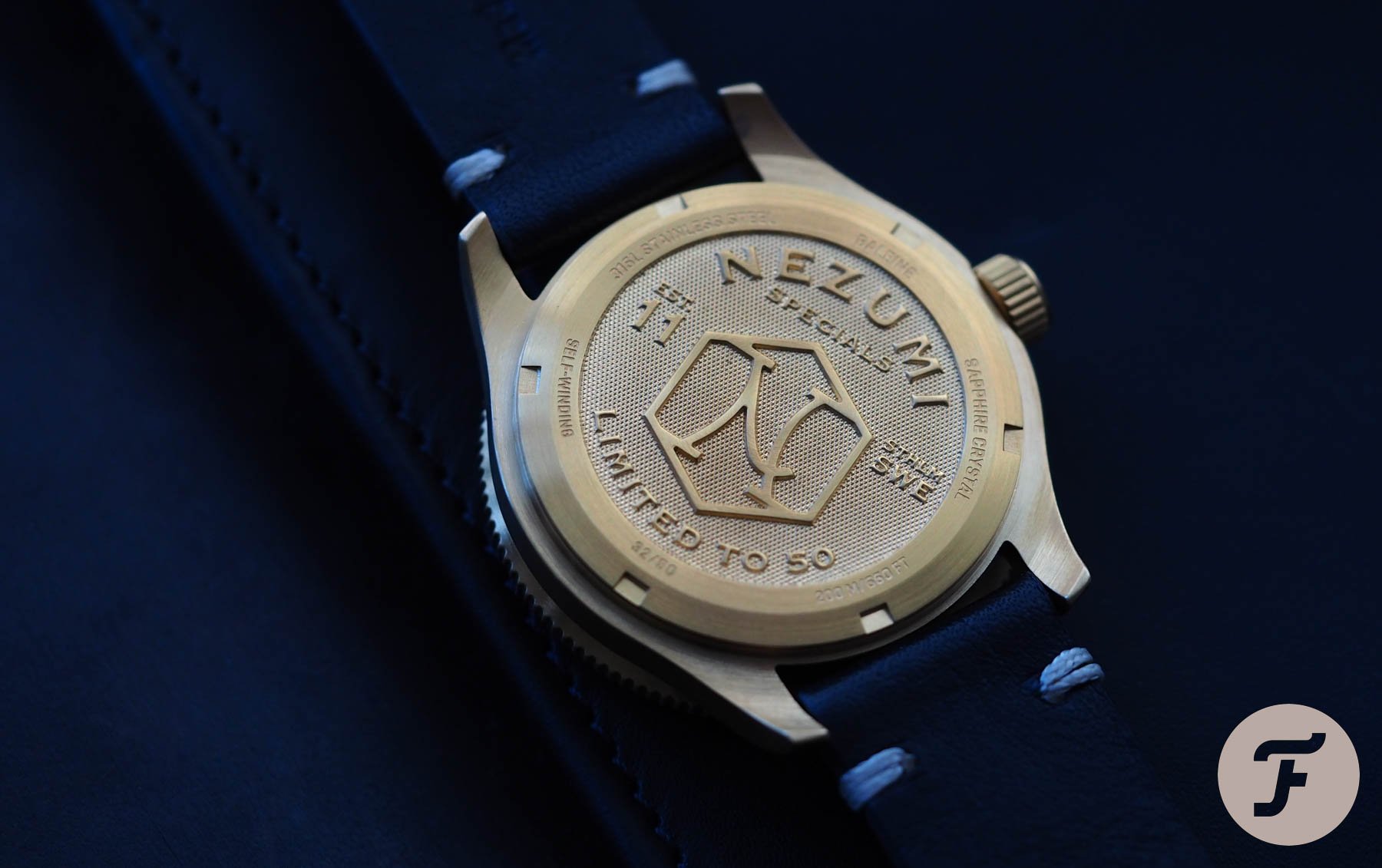Hands-On With The Nezumi Baleine Automatic Dive Watch
As many of you will know by now, I’m a big fan of Swedish brand Nezumi. I love the designs. I love the price. And a big part of me loves the Meca-Quartz movements employed by the brand regularly. But within the Nezumi catalog, there is one odd duck. On an island — an automatic island — stands the Nezumi Baleine Diver. It’s a model that’s been in the collection before, but took a hiatus during which time its design was tweaked before returning to the lineup recently. I decided it was time to bite the bullet and try something different… In gold, no less…
Okay, the Nezumi Baleine automatic dive watch is not solid gold. At under €500 that would be truly remarkable. No, this model is DLC-coated to give it a rich and distinct character that sets it apart from the rest of the current steel models. Do I like gold? Not normally, no, but as I was preparing to make a Baleine model my sixth Nezumi (seriously), I thought I might as well take a flyer on something a bit “out there”. Additionally, this color is a proprietary blend for Nezumi and Nezumi alone. That’s an interesting note for fans of exclusivity!
…the warmer side of watchmaking…
Mike and RJ have been talking about their Moonshine gold Speedmasters recently, and how they feel their age played a part in them being ready for gold. Well, I’m a few years younger than my devilishly handsome colleagues, despite looking far worse for wear. As such, I wasn’t sure I was ready for the real deal. The Nezumi Baleine automatic dive watch seemed like a smart, cost-effective way to see how the warmer side of watchmaking looks on my wrist.
Fandom aside
Like I said at the top, I’m a big fan of Nezumi. That does unavoidably result in a bit of bias. However, I’d like to make it clear that my bias exists only in my anticipation of a product. By the time I get round to analyzing something in the metal, I often find the high-expectations I bestow upon some brands to be more of a hindrance than a help to them. I will not, nor will I ever, skirt around design elements I don’t like about a watch simply because I love a brand and want to love its products.
So let me get this out there right away: yellow gold is not for me. After wearing the Baleine in gold for about three weeks solid, I decided I wished I bought the steel. That’s the truth. I like this model a lot, but my problem with this specific model is threefold.
A personal take
First, I just don’t think it suits me. The grittiness of steel matches up with the rest of my wardrobe so much better I would always find myself reaching for my original Voiture (currently looking the absolute business on a rooster foot leather strap from LIC in Belgium), or the military-styled Nezumi Corbeau. I wore that Corbeau to death over the summer whenever I took my fixie out for a spin and it was a remarkable joy.
I would advocate a golden-bezel Baleine in the future.
Secondly, the steel watches from Nezumi are just so incredibly well designed, topping them would take something truly remarkable. Design congruity is really one of founder David Campo Cardenes’ strengths. The design language of the brand is clearest when the steel spokespeople stand up to be counted. I feel the same way about this gold model as I do about the black-cased Corbeau pieces and the Baleine/Anthrax limited edition we saw in our very own This Week in Watches column recently.
Thirdly, it isn’t the best gold-colored model Nezumi has made in recent months. The Loews Chronograph in gold (also limited to 50 pieces) worked better, I believe, because of its dressier layout to begin with. That’s not to say a bit of gold can’t work in the Baleine family, however, far from it. I have the (recently re-released) Nezumi Voiture with a gold bezel, crown, and pushers. It’s amazing. It is sporty and classy. Best of all, the tiny flashes of gold don’t have enough presence to become overbearing. In light of the runaway success of that model, I would advocate a golden-bezel Baleine in the future.
Different strokes for different folks
However, I noticed something odd about the reaction of the people around me when I showed them this watch. It would seem non-watch people (or Muggles, as I like to call them) think this watch looks the business. I got far more looks, far more comments, and far more interest in this model than I get when wearing a steel watch. If the “wow” factor is what you’re after, this one definitely has it.
My favorite Nezumi model is the Voiture; second to that, is the Corbeau. Despite owning the blue-dialed variant, the Loews never moved me. It does, however, spend an inordinate amount of time on my girlfriend’s wrist. It is her favorite by a country mile. Similarly, that bright, vivacious dial appealed to my brother — a fledgling watch fan that has a couple of decent pieces in his collection and a lot of lower-end bits he likes to cycle through regularly. Until I showed him this new Baleine, the blue-dialed Loews had been his favorite. That is no longer the case.
In fact, he was so taken by the Baleine that I was forced to reconsider my feelings. I was a bit surprised at his buoyant enthusiasm for it, but after he questioned me on the watch, I started to feel it a bit more myself:
“This is from that Swedish brand you’re always banging on about, right? The one you and Tom backed on Kickstarter years ago.”
“That’s right. It’s the new diver.”
“Is it real gold?”
“No, DLC. This one is automatic, though.”
“So it’s more expensive then?”
“Well… No, actually, it’s about the same… And it’s limited to 50 pieces…”
“Huh? How does that work?”
Fair question, bro. Fair question…
A good point from an odd source
As it turns out, my unnecessarily tall kid brother has a point. How does that work? For those of us in the industry, pricing theory is a frequent topic of conversation and passionate debate. To cut several long stories short, the general theory is that a watch must retail for at least four times the amount it cost to make it. As we climb higher up the luxury tree, the cost/retail ratio changes, of course, but at the very bottom, that’s roughly what you’re looking at as a baseline.
…a totally uninflated reflection of costs in the retail.
Therefore, logic dictates that any increase in investment made by the brand will manifest as a significant increase in retail costs. The difference in retail between the steel Baleine model and the steel Loews chronograph is €0. The difference in price between a VK Meca-Quartz module and a basic automatic is about €10 (depending on ordering quantities it could be less) so we’re looking at a totally uninflated reflection of costs in the retail. Realistically, every automatic Nezumi should be about 10% more than the Meca-Quartz version. They are not. Do you know what that means? Value.
Furthermore — and this is the biggy — automatic movements are far less reliable than their quartz counterparts and brands should always be prepared to deal with aftersales concerns should they arise. One way smaller brands sometimes cover for this is to add at least the cost of a replacement movement to the price so they can just flip it and be done with it if the original caliber completely gives up the ghost, but here that doesn’t seem to have happened.
The money has been spent in the right way
And so Nezumi has kept the price lower than it might have done if it had been feeling a bit greedy, which is nice. What is nicer though, is the way the price difference between quartz and mechanical reflects where the bulk of the money has been spent in making these watches.
The movement is a necessary component, but it is not what makes the Nezumi brand tick.
It shows us how cheap a component the movement and the module is in comparison to the rest of the product. This is exactly what I always preach goes into making a good brand in this price bracket. The movement is a necessary component, but it is not what makes the Nezumi brand tick. The design and execution thereof is everything. And so the Baleine gives us an automatic option for effectively nothing on top, while shifting the focus back (again and rightly so) to the way this thing looks.
Aesthetic analysis
Once again, Nezumi has created a strap monster. These watches have no right to look as good on after-market straps as they do, but they seem unable to help it. I’ve currently got it on a waxed green leather two-stitch. It looks awesome and I’m enjoying it for a few more weeks before I surprise my brother with it (don’t worry, he doesn’t read Fratello). I want more people to enjoy the Nezumi vibe, and this is the perfect entry piece for him. Why? Because for €404 it is just about the most exciting thing I can find on the market.
The machining of the case middle, crown, case back, hands, and dial is excellent as ever. The screw-down crown of this 40mm case is a nice size, easy to grip, and catches the thread nicely with no grinding while screwing or unscrewing it. In my opinion, the only drawback of the crown is its dead second position and the phantom click of a non-existent date flipping over (at twenty past seven on my model). I’ve started pretending it is a rudimentary alarm function (because the thought amuses me). As a result, it doesn’t bother me half as much as I thought it would, but I appreciate it will irk some people more.
Neat details
One of my favorite aspects of the design is the polished (and nicely sized) handset. The hands are really nicely polished with a great luster at this price point. The painted tip of the polished seconds hand is a real easter egg that I enjoy looking at every time. Better still, the paint is luminous so it acts as a proper running indicator in the dark.
When it comes to the dial layout, the Baleine is incredibly sound. It is balanced, crisp, brought to life with a complementary colorway. The 24-hour indicators at each hour marker are a nice touch. If you like the Baleine layout, but find yourself craving something a bit more…extreme, Nezumi Studios also created a limited edition of the Baleine diver in a collaboration with thrash metal band Anthrax — you can read all about that one over at Old News Club right here.
As always, I’m impressed with the buckle design. It is too rare that brands make any effort at all with the buckle and I’m pleased to see a proprietary shape employed once more. These new Nezumi buckles are a big upgrade on the stock lasered ones we got with our first Kickstarter order years ago.
Conclusion
My least favorite aspect of the build is the bezel action. There’s a bit too much play for my liking. There is a bit of side-to-side wiggle and, if you force it (which I like to do because testing these things thoroughly is my job), you can shift it backward around one-third of a click. During general wear, however, the bezel performs admirably and the pronounced lume pip at 12 is unmissable in the dark. It has excellent glow homogeny with the hands, but the dial lume lags way behind. It isn’t actually necessary given the performance of the pip and the handset, but worth mentioning if blazing numbers are your thing.
Nezumi boxes are effectively works of art.
I adore the Nezumi case backs. I thought I would be bored by roughly the same design on so many models, but I just think it works. It is clean, it is clear, it is on-brand. For some reason, they remind me of old-fashioned tins of ammunition or produce from the heydey of packaging design. And speaking of the packaging, the Nezumi boxes are effectively works of art. I display all of mine in my office, quite proudly too, I might add.
To summarize, this is yet another very good product from a brand that rarely disappoints me. That said, this is not the one for me. I will continue to expand my collection of Voiture models as time passes and will probably look to add another Nezumi Corbeau at some point too (I fancy the gray dial with black sub-dials next, I think). However, should Nezumi continue to explore the mechanical direction and branch out into manual-wind chronographs, you would find me very, very interested. Check out Nezumi’s official site and sign-up to the mailing list to keep on top of new releases.

